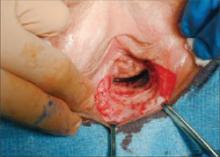A practical approach to vestibulitis and vulvodynia
Draw a few basic distinctions and apply simple strategies to aid your diagnosis and management of these all-too-common conditions
IN THIS ARTICLE
Vestibulectomy is the treatment of choice
Multiple studies suggest 61% to 94% improvement or cure after vestibulectomy.6 A key predictor of surgical failure is constant vulvar pain in addition to pain with coitus.7 Such patients should probably be managed by an expert.
Before deciding on vestibulectomy, confirm that the patient has had persistent symptoms for more than 6 months. The reason? Spontaneous remission does sometimes occur within the first 6 months of vestibulitis.
In the OR, after induction of anesthesia, apply downward and lateral pressure to the posterior fourchette to bring small fissures to light. Vestibulectomy entails removal of the hymen and vestibular skin out to Hart’s line. This usually means removal of all of the vestibule except the part just lateral to the urethral meatus (FIGURE 2).
Once this tissue is removed, mobilize the vaginal epithelium, as in posterior colporrhaphy, and advance it to cover the surgical defect.
FIGURE 2 Excision of the vestibule
Vestibulectomy involves removal of the entire vestibule except the part just lateral to the urethral meatus.
Postoperative immobilization is required
After surgery, the patient should expect to be somewhat immobilized for 2 weeks and to require narcotic analgesia during this time. Healing should be apparent by 6 postoperative weeks, but the suture line at the introitus may still be slightly tender. I usually recommend that the patient avoid coitus until the 3-month postoperative visit. At this visit, the introitus should no longer be tender. If this is the case, the patient can be given the green light for coitus.
In older women, look for genital atrophy
Postmenopausal women are remaining sexually active in ever-increasing numbers. When dyspareunia occurs in this population, the cause is usually genital atrophy. Long-term treatment with systemic or topical estrogen will usually ease coital pain. Surgery is not a mainstay of treatment of dyspareunia in postmenopausal women. (For more on this population, see “Postmenopausal dyspareunia: A problem for the 21st century,” by Alan Altman, MD, in the March 2009 issue of OBG Management at www.obgmanagement.com.)
Essential vulvodynia is more common among older women
Women who have essential (dysesthetic) vulvodynia tend to be older and postmenopausal, although premenopausal women are sometimes affected. These women complain of chronic, unremitting, diffuse vulvar burning that is usually not limited to the vestibule. They may have similar symptoms in the region of the urethra and rectum. In general, dyspareunia is not a major problem.
In women who have essential vulvodynia, the pelvic examination is absolutely normal other than the presence of mild genital atrophy in the postmenopausal patient. There is no evidence of provoked tenderness and no focal erythema or erosion.
Treatment is medical
Women who have essential vulvodynia are not candidates for surgery. Optimal treatment of this neuralgia entails the use of low-dosage amitriptyline (25 to 50 mg nightly) or other antidepressants (e.g., venlafaxine, sertraline, duloxetine).8 I prefer low-dosage sertraline (25 mg daily) because it has a low incidence of side effects at this dosage.
Less is more in the pharmacotherapeutic management of essential vulvodynia. Women who do not respond to a lower dosage tend not to respond to a higher one, either.
Another option is gabapentin. It usually is administered orally but was recently studied in a topical formulation, both of which appear to be effective.9,10
Counsel the patient that improvement, not cure, is the therapeutic goal with these drugs and that her response will be gradual, with improvement usually noticed after 2 weeks of therapy, continuing until her 6-week revisit. At that time, the dosage can be maintained or increased, depending on the patient’s response. If the patient is happy with that response, treatment should continue for 4 months, at which point she can be weaned from therapy. Relapse is uncommon.
CASE: OUTCOME
Upon examination, the patient exhibits focal erythema at the junction of the hymen and vestibule. Palpation of these areas with a moist cotton swab causes extreme tenderness, recreating the patient’s introital pain. Microscopy of the vaginal secretions is normal, and a vaginal yeast culture is negative.
Because she is an excellent candidate for vestibulectomy, the patient undergoes resection of the vulvar vestibule from the hymenal ring to Hart’s line, from the 1 o’clock to 11 o’clock positions, and recovers slowly.
At her 6-week postoperative checkup, the surgical site is healed but tender. At her 3-month visit, the introitus is no longer tender, erythema has resolved, and she resumes coital activity.







